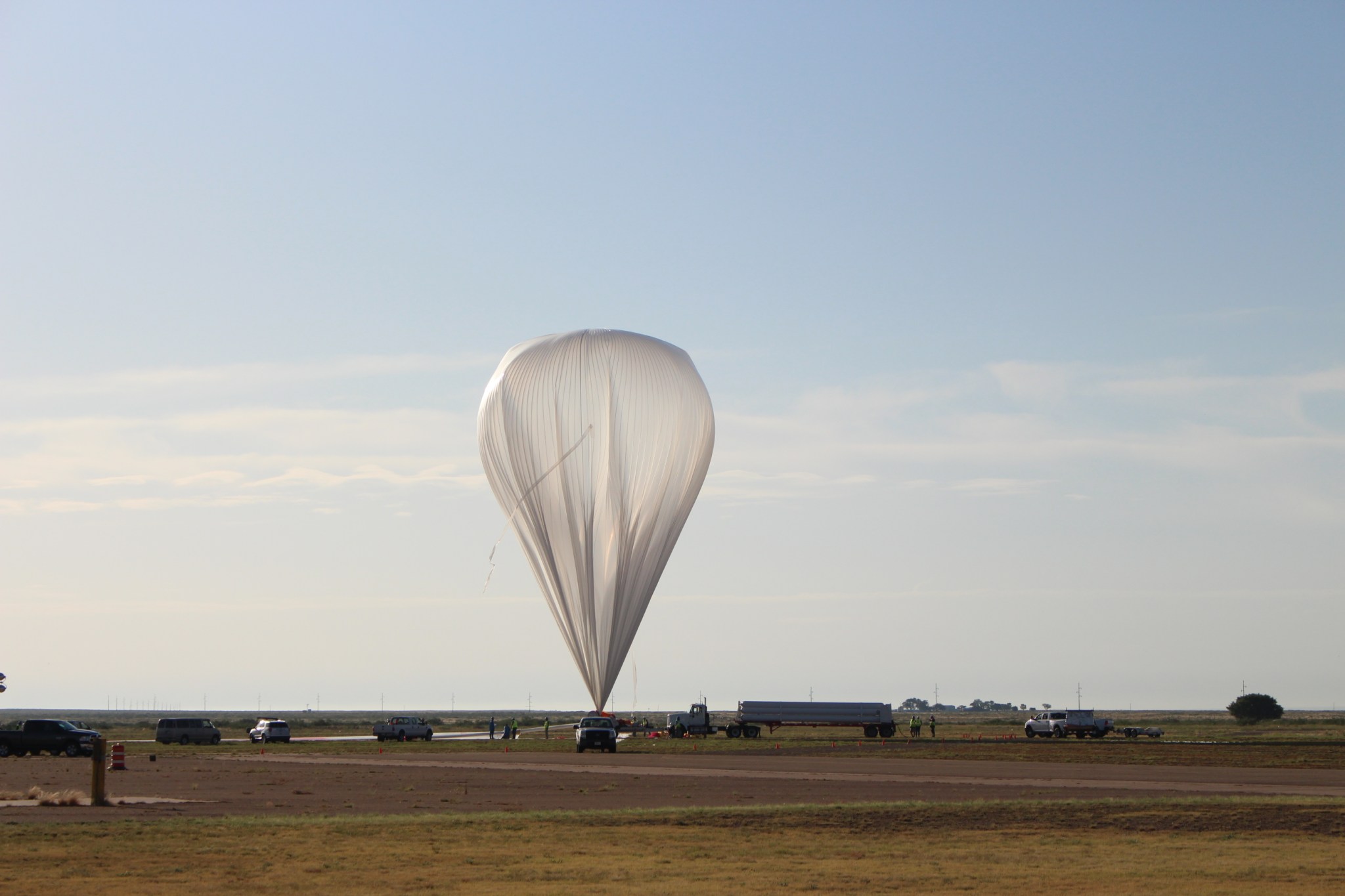NASA successfully launched a scientific balloon at 9:59 a.m. EDT, Thursday, Aug. 22, from New Mexico – the first in a series of launches in the 2019 Fort Sumner campaign.
The 29 million cubic-foot, zero-pressure balloon lifted NASA’s Balloon-Borne Cryogenic Telescope Testbed, better known as BOBCAT, to a float altitude of 130,200 feet. Launch to landing, the 1,821-pound BOBCAT mission spent about 8 hours airborne – and stayed at float altitude for 4 hours and 26 minutes, achieving its science goals.
BOBCAT is a technology demonstration developed by Dr. Alan J. Kogut of NASA’s Goddard Space Flight Center in Greenbelt, Maryland. Kogut and his team plan to develop a series of experiments for balloon flights that would radically improve the sensitivity of the next generation of observations in the far-infrared universe, which is a wavelength commonly used to study black holes, nebulas and the formation of new solar systems.
“Most of the far-infrared light from space is blocked by Earth’s atmosphere and does not reach even the highest mountain-top observatories. Astronomers can mitigate this by bringing their observatories off the ground and into the sky. For instance, NASA uses a flying observatory called SOFIA, or Stratospheric Observatory for Infrared Astronomy, to collect mid- to far-infrared observations from 40,000 feet. The BOBCAT mission hopes to one day lift an experiment even higher to around 120,000 feet where the atmosphere is even thinner.”
“If you have a combination of a cold telescope and the thinner atmosphere at a balloon’s float altitude, you could do science even faster.” he said. “BOBCAT will help us develop the next generation of observatories that can build and improve on infrared research.”
But flying a cold observatory isn’t possible at a balloon’s altitude yet – the mechanism to keep a telescope’s mirrors cold for better observations would be too heavy. The mirrors would need to be inside a dewar, a container like a large thermos bottle that stores cryogens like liquid nitrogen or helium. Getting the cryogens into the dewar is much harder at balloon altitudes than it is on the ground.
“On the ground, you can squirt liquid nitrogen through a hose and it comes out as a liquid,” said Kogut. “At a balloon’s altitude, if you transfer liquid nitrogen, it comes out the other end as a solid, much like how carbon dioxide fire extinguishers come out as a solid-like foam.”
Kogut and his team demonstrated the ability to solve this problem during the Aug. 22 flight of the first BOBCAT mission, where they successfully transferred cryogens from one vessel container to another at a height of more than 120,000 feet.
After accomplishing their goal, the team is now moving onto their next mission. BOBCAT-2 will demonstrate the ability to build and fly a thin, lightweight dewar that would function at balloon altitude.
While a dewar on the ground has to have thick, heavy walls to withstand air pressure, Kogut said that’s not the case at a balloon’s altitude, where the atmosphere is just half of 1% as thick as at sea level. If the team can wait until BOBCAT-2 reaches balloon altitude to fill the dewar, the walls would only have to be as thick as a can of soda. This breakthrough would reduce the weight carried by the balloon dramatically.
“The dewar flying on BOBCAT-2 couldn’t work on the ground,” said Dr. Kogut. “It would be crushed like a bug with the pressure of our atmosphere. Luckily for us, it doesn’t have to work on the ground. It only has to work at float.”
For now, Kogut says he could not have asked for a better launch of the first BOBCAT mission. The mission floated about 10,000 feet higher than the team had hoped for, allowing ample time and altitude to smoothly achieve their science goals.
While the science team had their eyes on the BOBCAT experiment, a team from NASA’s Wallops Flight Facility in Wallops Island, Virginia, and NASA’s Columbia Scientific Balloons Facility in Palestine, Texas, were carefully monitoring zero-pressure balloon operations.
“We had a very smooth launch this morning,” said Amy Canfield, mission manager in NASA’s Scientific Balloon Program. “From the moment we started inflation to the moment we sent the command to bring the balloon down in Eastern Arizona, all systems performed nominally. It was a beautiful morning for a launch.”
The team successfully recovered BOBCAT and its balloon in Eastern Arizona and brought it back to the Fort Sumner facility for further evaluation.
The launch of the BOBCAT mission kicked off the first of many back-to-back missions from NASA’s scientific balloon program. Future flights in the campaign include the Long-Duration Balloon (LDB) test flight and NASA’s BITSE mission (Balloon-borne Investigation of Temperature and Speed of Electrons in the corona).
The LDB test flight will evaluate possible improvements to balloon flights. During long-duration balloon flights, a balloon may to drift to a remote location and lose contact with a ground station. The LDB flight will test a way of communicating with NASA’s Tracking and Data Relay Satellite System (TDRSS) to downlink data from the experiment and the scientists back on the ground when the balloon is out of range. The test flight will also evaluate new lightweight equipment and in-flight cameras.
BITSE is an airborne coronagraph. Coronagraphs are instruments that block the majority of the Sun’s light to reveal its upper atmosphere called the corona – much like how the Moon blocks the Sun’s bright light during a solar eclipse.
The LDB test flight and BITSE are just a couple flights in the lineup of zero-pressure balloon flights NASA’s Balloon Program Office has planned in Fort Sumner.
“The flight manifest is extremely full this campaign with nine large balloon and four small balloon launches, so we’ve really only just begun,” said Andy Hynous, mission operations manager for NASA’s Balloon Program Office. “NASA has been working diligently with science teams from across the globe to prepare the missions in our campaign, and it is always an awesome feeling to get the first mission off the ground and into the stratosphere.”
To follow along with the missions in the 2019 Fort Sumner campaign, visit NASA’s Columbia Scientific Balloon Facility’s website for real-time updates of a balloon’s altitude and GPS location during flight.
NASA’s Wallops Flight Facility in Virginia manages the agency’s Scientific Balloon Program with 10 to 15 flights each year from launch sites worldwide. Northrop Grumman, which operates NASA’s Columbia Scientific Balloon Facility in Palestine, Texas, provides mission planning, engineering services and field operations for NASA’s scientific balloon program. CSBF has launched more than 1,700 scientific balloons in the over 35 years of operation. Raven Aerostar provides fabrication of NASA’s stratospheric balloons.
For more information on the balloon program, visit: https://www.nasa.gov/scientificballoons.
By Chelsey Ballarte
NASA’s Wallops Flight Facility, Wallops Island, Va.
































